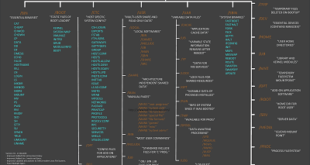I have a dual-monitor setup and I am trying to use use different wallpapers on multiple monitors in Linux. What I want is simply to have a different background on each of the two monitors. Most of the solutions I Googled were about Ubuntu and about virtual desktops (aka workspaces). I only use one workspace, but two monitors, i.e. my laptop and a monitor attached via VGA cable. As you can see from the screen-shot below, I finally managed to find a good solution to use different wallpapers on multiple monitors in Linux (well it seems to be working for an unlimited number of Monitors)
Read More »Yearly Archives: 2015
Linux file system hierarchy v2.0
What is a file in Linux? What is file system in Linux? Where are all the configuration files? Where do I keep my downloaded applications? Is there really a filesystem standard structure in Linux? Well, the above image explains Linux file system hierarchy in a very simple and non-complex way. It's very useful when you're looking for a configuration file or a binary file. I've added some explanation and examples below, but that's TL;DR.
Read More »How to get Public IP from Linux Terminal?
Public addresses are assigned by InterNIC and consist of class-based network IDs or blocks of CIDR-based addresses (called CIDR blocks) that are guaranteed to be globally unique to the Internet. When the public addresses are assigned, routes are programmed into the routers of the Internet so that traffic to the …
Read More »DoS website using slowhttptest in Kali Linux – slowloris, slow HTTP POST and slow Read attack in one tool
SlowHTTPTest is a highly configurable tool that simulates some Application Layer Denial of Service attacks. It works on majority of Linux platforms, OSX and Cygwin – a Unix-like environment and command-line interface for Microsoft Windows. It implements most common low-bandwidth Application Layer DoS attacks, such as slowloris, Slow HTTP POST, …
Read More »Skype bug crashes Windows, iOS and Android versions of Skype application
A recent Skype bug discovered by VentureBeat can crash Skype in Windows, iOS and Android versions. All it takes is sending or receiving http://: in a message. It crashes the Windows app if you're the sender and completely kills it if it's the one receiving that string of characters. However, the iOS and the Android apps are only affected when they're the recipient, and Skype for Mac seems to be immune from the issue.
Read More » blackMORE Ops Learn one trick a day ….
blackMORE Ops Learn one trick a day ….




